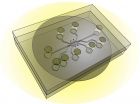(Press-News.org) HOUSTON – (Sept. 22, 2014) – As genetic sequencing technologies continue to evolve rapidly, becoming part of clinical care, there is a critical need to establish appropriate policies and regulatory frameworks to address potential challenges, legal and ethical experts have said. A special policy issue of the Journal of Law, Medicine & Ethics published online today and edited by experts with the Center for Medical Ethics and Health Policy at Baylor College of Medicine gives policy makers the tools to jumpstart this process.
Experts with the Center for Medical Ethics and Health Policy at Baylor were tapped to serve as editors of this special issue of the journal, which addressed a variety of topics including U.S. Food and Drug Administration regulation, reimbursement, intellectual property issues, and proprietary databases. They did so with the help of a $1.6 million National Human Genome Research Institute grant to Dr. Amy McGuire, director of the Center and a leading expert on legal and ethical issues in genetics. The grant allowed experts to study how the evolution of the next generation sequencing industry impacts these major policy areas.
Next generation sequencing technologies allow clinicians and scientists to determine the precise order of nucleotides – or building blocks -- in a DNA sequence.
"This special issue of the journal represents the most comprehensive analysis to date of legal and policy issues associated with the clinical integration of next generation sequencing," said McGuire.
In an introductory commentary included in the issue, authors McGuire, Dr. David Kaufman, director of research at the Genetics and Public Policy Center at Johns Hopkins University in Washington, D.C., and Dr. Margaret Curnutte, a post-doctoral fellow in the Center for Medical Ethics and Health Policy at Baylor, highlight the priority areas of policy uncertainty.
"Next generation sequencing is potentially transformative for genetic testing applications because it allows clinicians to look broadly across the genome to identify a wide range of genetic changes that are, or may in the future be, clinically significant, as well as to more precisely diagnose and treat disease," the authors noted in the introduction. "The potential expansion of clinical utility and the decreasing costs have brought next generation sequencing methods to the cusp of mainstream clinical diagnostic testing."
There are a host of policy challenges facing clinical integration that must be addressed before genomic sequencing is available for routine clinical use. Though many companies and laboratories involved in clinical sequencing are working to address these issues, there continues to be much variability in analysis – which is why the journal's editors called on McGuire and her team to coordinate the current issue's special focus.
"We believe that a more coordinated approach to policy development is needed since this technology presents several challenges that lie outside existing regulatory frameworks," the authors noted.
Reports in the current issue authored by leading experts on each subject were designed to provide policy makers with the most comprehensive background to address policy making decisions.
The highlighted articles included in the journal provide in-depth reports on some of the most pressing issues:
Regulation of clinical genetic testing by the Center for Medicare and Medicaid Services through its Clinical Laboratory Improvement Amendments, state law, and the FDA, by legal experts Gail Javitt, of the Johns Hopkins Berman Institute of Bioethics and counsel at Sidley Austin LLP, and Katherine Carner, associate with Allen Boone Humphries Robinson LLP.
Comprehensive review of the coverage and reimbursement environment confronting clinical next generation sequencing authored by Dr. Patricia Deverka, an adjunct associate professor at the University of North Carolina at Chapel Hill School of Pharmacy, and Jennifer Dreyfus, principal of Dreyfus Consulting, LLC.
Examination of current case law related to the patenting of human genes by Dr. Robert Cook-Deegan, of the Sanford School of Public Policy at Duke University and Dr. Subhashini Chandrasekharan of the Global Health Institute also at Duke University.
Discussion of the legality of proprietary databases held as trade secrets by Dr. Barbara Evans, director of the Center for Biotechnology & Law at the University of Houston Law Center.
"There is an immediate need for critical thought about what the highest policy priorities surrounding clinical next generation sequencing are and how we may begin to address them," the introduction authors said. "To develop policy priorities for clinical NGS in the absence of robust clinical data, we suggest input and deliberation from a broad array of stakeholders including NGS technology and informatics companies, clinical laboratories, health care professionals, insurers, regulatory and public health agencies, health economists and patient groups."
It is our hope that the scholarship in this issue will begin to generate such conversations, and provide policy makers with access to sound policy options based on wide-ranging expert opinions and rigorous research, they said.
INFORMATION:
Glenna Picton
713-798-4710
picton@bcm.edu
http://www.bcm.edu/news
Experts provide much-needed policy analysis for clinical integration of next generation sequencing
2014-09-22
ELSE PRESS RELEASES FROM THIS DATE:
Can tapioca replace corn as the main source for starch sweeteners?
2014-09-22
New Rochelle, NY, September 22, 2014—Cassava, also known as tapioca, has large starch-filled roots and can grow at high yields in areas of Africa, Asia, and Latin America where corn and sugarcane are not commonly grown. With the availability of novel enzymes and processes designed to break down tapioca starch into sugars that can then be used to produce sweeteners such as glucose, fructose, or maltose syrup, tapioca may be an ideal alternative to corn, as described in a Review article in Industrial Biotechnology, a peer-reviewed journal from Mary Ann Liebert, Inc., publishers. ...
Kessler pilot study demonstrates benefits of wellness program for people with MS
2014-09-22
West Orange, NJ. September 22, 2014. Kessler researchers have published a pilot study showing the benefits of a 10-week psychoeducational wellness program in people with multiple sclerosis (MS). Improvements were seen in mood, overall mental health, perceived stress, and pain. "Development and effectiveness of a psychoeducational wellness group for individuals living with MS: Description and outcomes" was epublished ahead of print on September 3 in the International Journal of MS Care (doi: 10.7224/1537-2073.2013-045). The authors are Kimberly Beckwith McGuire, PhD, of ...
Priorities for research on pharmaceutical and personal care products in the environment
2014-09-22
PENSACOLA, Fla. – In 2011 the Society of Environmental Toxicology and Chemistry (SETAC) held a workshop for 45 international experts to identify and prioritize the scientific research needed to understand the risks of pharmaceuticals and personal care products (PPCPs) in the environment. The effort was extended, and results were published in the most recent issue of the Society's international journal, Integrated Environmental Assessment and Management (IEAM). The published work is accompanied by a podcast interviewing the lead author of the study, Murray Rudd from the ...
Wildfires in Khabarovsk Krai, Russia
2014-09-22
Most of the fires captured in this image burn in Khabarovsk Krai, a territory occupying the coastline of the Sea of Okhotsk. Dozens of red hotspots, accompanied by plumes of smoke mark active fires. The smoke, which appears mostly white or grey, blows to the east towards the Sea of Okhotsk. Taiga and tundra are found in the north of this area, swampy forest inhabit the central depression, and deciduous forests are the natural vegetation in the south.
While large wildfires are common in Russia in the summer, the 2014 wildfire season appears to be more intense than usual. ...
New chip promising for tumor-targeting research
2014-09-22
WEST LAFAYETTE, Ind. – Researchers have developed a chip capable of simulating a tumor's "microenvironment" and plan to use the new system to test the effectiveness of nanoparticles and drugs that target cancer.
The new system, called a tumor-microenvironment-on-chip (T-MOC) device, will allow researchers to study the complex environment surrounding tumors and the barriers that prevent the targeted delivery of therapeutic agents, said Bumsoo Han, a Purdue University associate professor of mechanical engineering.
Researchers are trying to perfect "targeted delivery" methods ...
Brainwave test could improve autism diagnosis and classification
2014-09-22
September 22, 2014 – (BRONX, NY) – A new study by researchers at Albert Einstein College of Medicine of Yeshiva University suggests that measuring how fast the brain responds to sights and sounds could help in objectively classifying people on the autism spectrum and may help diagnose the condition earlier. The paper was published today in the online edition of the Journal of Autism and Developmental Disabilities.
The U.S. Centers for Disease Control and Prevention estimates that 1 in 68 children has been identified with an autism spectrum disorder (ASD). The signs and ...
Common diabetes drug associated with risk of low levels of thyroid hormone
2014-09-22
Metformin, a commonly used drug for treating type 2 diabetes, is linked to an increased risk of low thyroid-stimulating hormone (TSH) levels in patients with underactive thyroids (hypothyroidism), according to a study in CMAJ (Canadian Medical Association Journal). Low levels of TSH can cause harm, such as cardiovascular conditions and fractures.
Metformin is used to lower blood glucose levels by reducing glucose production in the liver. However, some previous studies have raised concerns that metformin may lower thyroid-stimulating hormone levels.
Researchers looked ...
University of Chicago neuroscientists challenge long-held understanding of the sense of touch
2014-09-22
Different types of nerves and skin receptors work in concert to produce sensations of touch, University of Chicago neuroscientists argue in a review article published Sept. 22, 2014, in the journal Trends in Neurosciences. Their assertion challenges a long-held principle in the field—that separate groups of nerves and receptors are responsible for distinct components of touch, like texture or shape. They hope to change the way somatosensory neuroscience is taught and how the science of touch is studied.
Sliman Bensmaia, PhD, assistant professor of organismal biology and ...
Variability keeps the body in balance
2014-09-22
Although the heart beats out a very familiar "lub-dub" pattern that speeds up or slows down as our activity increases or decreases, the pattern itself isn't as regular as you might think. In fact, the amount of time between heartbeats can vary even at a "constant" heart rate—and that variability, doctors have found, is a good thing.
Reduced heart rate variability (HRV) has been found to be predictive of a number of illnesses, such as congestive heart failure and inflammation. For athletes, a drop in HRV has also been linked to fatigue and overtraining. However, the underlying ...
NASA sees Tropical Depression Polo winding down
2014-09-22
Infrared satellite imagery from NASA's Aqua satellite showed only a swirl of low-level clouds some deep clouds around Polo's weakening center on Sept. 22 as the storm weakened to a depression.
The Atmospheric Infrared Sounder or AIRS instrument aboard Aqua gathered infrared data on Polo on Sept. 22 at 5:11 a.m. EDT, reading cloud top temperatures. There was a small area of high clouds, indicating that most thunderstorms in the depression had weakened or already dissipated except for that area.
At 5 a.m. EDT on Monday, Sept. 22, Tropical Depression Polo's maximum sustained ...



